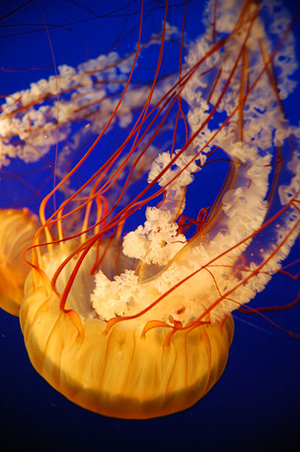
Scientists are beginning to determine the full impact of the oil spill in the Gulf of Mexico and help guide its recovery. And they will need to know about all the creatures that lived in the water before the oil began gushing – from the commercial shrimp to rarely seen giant squid and microorganisms.
That’s where the Smithsonian comes in. The museum and research complex in Washington holds the most complete set of invertebrate species that live in the Gulf of Mexico.
The collection will serve as the scientific starting point for what lived there before the spill to measure the unseen impact, said Jonathan Coddington, head of research and collections at the National Museum of Natural History.
“Everybody and their brother is going to be going out to the Gulf and measuring stuff,” Coddington said. “A lot of the controversy is going to be about what the impact of the spill was.”
This collection will be the baseline to determine that, he said, surrounded by thousands of jars containing worms and other Gulf creatures preserved in alcohol in a suburban Maryland warehouse.
The collection includes more than 333,000 containers of invertebrates collected in the Gulf by the U.S. Minerals Management Service over the past 30 years. Another 39,000 jars are partially inventoried, though as many as 120,000 more haven’t been inventoried.
The spill, unleashed after a drilling rig leased by BP PLC exploded April 20, has made the backlog an urgent priority, Coddington said. It could cost $9 million to catch up all of the Smithsonian’s uncatalogued objects, he recently told a House panel.
The MMS conducted environmental surveys of the waters for years, specifically to help predict the impact of future gas and oil explorations. They began turning over the extensive collection to the Smithsonian for cataloging and safekeeping in 1979.
Overall, the collection documents at least 4,000 marine invertebrate species. Recent studies have shown the Gulf contains roughly 15,000 species overall and perhaps another 3,000 species still undiscovered.
On Wednesday, Smithsonian Secretary Wayne Clough will testify before a House science panel about the Smithsonian’s resources and research agenda. He has said the Gulf Coast invertebrates are a prime example of how useful the collections are.
The most recent addition from the Gulf arrived last year, and it’s a research project in itself.
A 26-foot-long giant squid housed in a large metal coffin and floating in alcohol was caught alive last year, which is rare. Usually such squid are found floating dead on the ocean surface and already rotting, said collections manager Cheryl Bright. So the recent catch gave scientists a glimpse at the squid’s body chemistry, stomach contents and other data.
All that information can be compared to creatures found after the oil spill.
Smithsonian scientists began putting the collection to use just days after the oil spill, creating a digital map showing where each specimen was collected from more than 5,700 sites in the Gulf. It turns out some animals had been collected near the spill site.
One spot within 20 miles of the Deepwater Horizon well, for example, is home to a deepwater coral that is a key reef-building species, making it fundamental to other marine life. If that base of the ecosystem is harmed, the domino effect on other species could be devastating.
Other Gulf invertebrates and organisms serve as food for shrimp and birds that humans see more often. So information from the collection could help settle conflicts about what the BP spill is responsible for.
“Shrimpers are going to say, ‘We’re just not seeing any big shrimp any longer.’ Then we’ll go back to these collections and say the average size of shrimp prior to the spill was this,” Coddington said. “It will come out which ever way it comes out. Facts help everybody.”
___
Online: National Museum of Natural History: http://www.mnh.si.edu/
Smithsonian Gulf Collection Map: http://invertebrates.si.edu/mms/files.htm
Copyright 2010 Associated Press. All rights reserved. This material may not be published, broadcast, rewritten, or redistributed.
AP-WS-07-21-10 1111EDT

